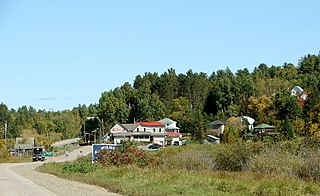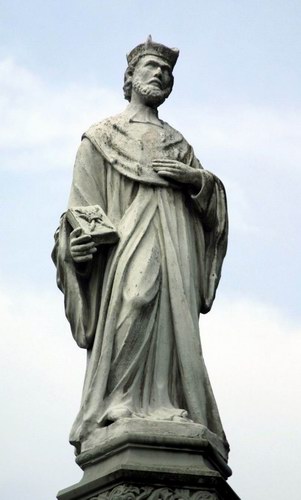
North Saint Paul is a city in Ramsey County, Minnesota, United States, located east-northeast of the city of Saint Paul. The population was 11,460 at the 2010 census.

Jordan is a city in Scott County, Minnesota, United States. The population was 6,656 at the 2020 census.

Winona is a city in and the county seat of Winona County, in the state of Minnesota. Located in bluff country on the Mississippi River, its most noticeable physical landmark is Sugar Loaf. The city is named after legendary figure Winona, who some sources claimed was the first-born daughter of Chief Wapasha of the Dakota people. The population was 25,948 at the 2020 census.

Polish Americans are Americans who either have total or partial Polish ancestry, or are citizens of the Republic of Poland. There are an estimated 8.81 million self-identified Polish Americans, representing about 2.67% of the U.S. population, according to the 2021 American Community Survey conducted by the U.S. Census Bureau. Polish Americans are the second-largest Central European ethnic group after German Americans, and the eighth largest ethnic group overall in the United States.

Wilno is a settlement in the Township Municipality of Madawaska Valley, Renfrew County, Ontario, Canada.

Slovene Americans or Slovenian Americans are Americans of full or partial Slovene or Slovenian ancestry. Slovenes mostly immigrated to America during the Slovene mass emigration period from the 1880s to World War I.

John Cantius was a Polish priest, scholastic philosopher, physicist and theologian.

Bridesburg is the northernmost neighborhood in the River Wards section of Philadelphia, Pennsylvania, United States. Bridesburg is an historically German and Irish community, with a significant community of Polish immigrants who arrived mostly in the early- to mid-twentieth century. The community is home to two Catholic churches: All Saints Church, designed by Edwin Forrest Durang, built in 1889; and Saint John Cantius Church, built in 1898 in Polish Cathedral style.

Saint John Cantius Church is a historic Catholic church of the Archdiocese of Chicago known for its architecture, liturgical practices, and affiliation with the Canons Regular of St. John Cantius.
Poles in Omaha, Nebraska arrived relatively early in the city's history. The first Polish immigrants came in the 1870s, and the community grew past 1000 in the late 1890s. By the 1930s there were 10,000 of Polish descent, and Omaha claimed the largest such community of the Great Plains. According to the 2000 United States Census, Omaha had a total population of 390,112 residents, of whom 18,447 claimed Polish ancestry. The city's Polish community was historically based in several ethnic enclaves throughout South Omaha, including Little Poland and Sheelytown, first dominated by Irish immigrants.

The Church of St. Wenceslaus is a Catholic church in New Prague, Minnesota, United States, constructed in 1907. The church is flanked by a 1908 rectory and a 1914 parochial school, and the three-building complex is listed on the National Register of Historic Places for its association with the Czech American settlement of south-central Minnesota.
Józef Franciszek Darzyn Ciemiński was a Polish-born Roman Catholic priest. He emigrated with his parents to the United States in 1881 and was ordained as a Priest in Saint Paul, Minnesota in 1895. He was involved with numerous Polish Catholic parishes during his lifetime including the now closed troubled Parish of Saints Peter and Paul in Duluth, Minnesota, and the parish of Holy Cross in Minneapolis.
The Kashubian diaspora resulted from the emigration of Kashubians mainly in two waves occurring in the second half of the 19th century. The majority of Kashubian emigrants settled in the United States; others emigrated to Canada and Brazil. An online genealogical project, "The Great Kashubian Migration," is devoted to tracking their settlement patterns. Their reasons for emigration varied. Until the Franco-Prussian War, Kashubians emigrated primarily for economic reasons. After the Franco-Prussian War and especially due to the Kulturkampf, Kashubian emigration accelerated as socio-political factors came into play. In his 1899 book, Statystyka ludnosci kaszubskiej, the Kashubophile linguist and sociologist Stefan Ramult estimated that 130,700 Kashubians were living in the Americas.

The Church of St. Hubertus is a historic Catholic church in Chanhassen, Minnesota, United States, built in 1887. It was listed on the National Register of Historic Places in 1982 for having local significance in the themes of "community planning and development" and "exploration/settlement". It was nominated for symbolizing the Franciscan brotherhood that platted and grew the German Catholic settlement that became Chanhassen.

The Church of St. Joseph is a historic Roman Catholic church building in St. Joseph, Minnesota, United States. It is part of the Roman Catholic Diocese of Saint Cloud. It was constructed in a German immigrant community in 1869, though the tower wasn't completed until 1884. A rectory stands east of the church. Both buildings were listed on the National Register of Historic Places in 1982 for their state-level significance in the themes of architecture, exploration/settlement, and religion. The property was nominated for reflecting the settlement of rural Stearns County by Catholic immigrant groups clustered in small, ethnic hamlets dominated by a central church.

The Church of the Immaculate Conception is a historic Roman Catholic church building in the unincorporated community of St. Anna, Minnesota, United States. It is part of the Roman Catholic Diocese of Saint Cloud. The church was constructed in 1902 in a rural community settled by Polish immigrants. It was listed on the National Register of Historic Places in 1982 for its state-level significance in the themes of architecture, exploration/settlement, and religion. It was nominated for reflecting the settlement of rural Stearns County by Catholic immigrant groups clustered in small, ethnic hamlets dominated by a central church.

The historic Church of St. Joseph is a church in Browerville, Minnesota, United States. It was built from 1908 to 1909 by a community of Polish immigrants that had established itself in the area from 1870 to 1900. The building was listed on the National Register of Historic Places as Church of St. Joseph—Catholic in 1985 for its local significance in the themes of architecture, exploration/settlement, and religion. It was nominated for its unifying central role in an immigrant community.

The Church of St. Michael is a historic Roman Catholic church building in St. Michael, Minnesota, United States, constructed in 1890. It was listed on the National Register of Historic Places in 1979 for having local significance in the themes of architecture, exploration/settlement, and religion. It was nominated for its status as the dominant architectural feature and the religious and social center of a German Catholic community.
Kashubian Americans are Americans of Kashubian descent.
John Radzilowski is an American historian, and author of numerous books and articles in the modern history of Poland and in the history of Polish-Americans. He is a professor of history at the University of Alaska Southeast.


















